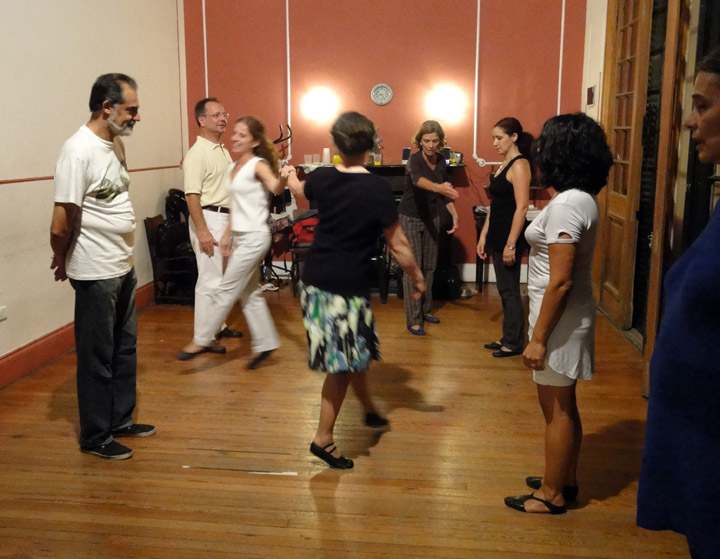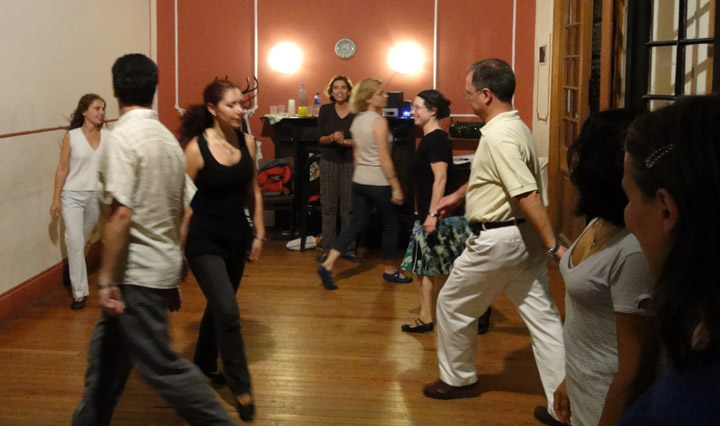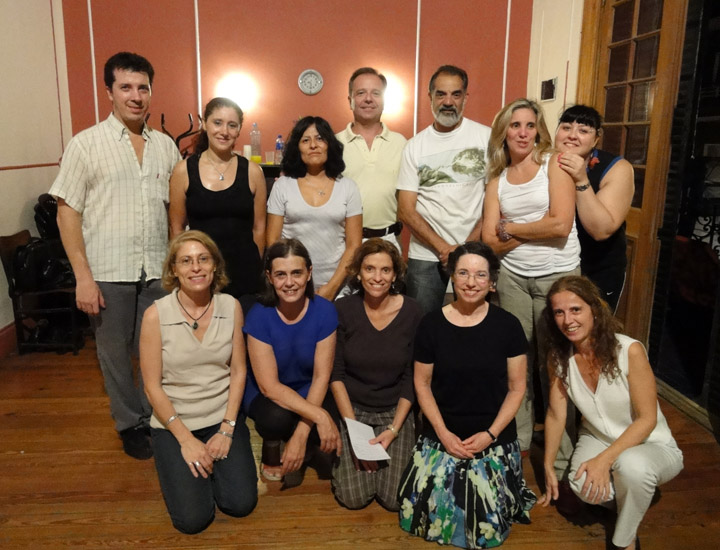
| Volume 36 #3 | November/December 2019 | |
 |
In addition to the transitions of the leaves from green to gold and orange, and of the season from summer to autumn, there has also been a transition in the position of editor of this newsletter. Martin MacKenzie, who has edited this newsletter for longer than any other person -- ever! -- has decided it was time to give someone else this mantel for a time. We all thank Martin for a job well done, lo, these many years. And, though no longer editor, he is still an avid contributer, as you will note in the line up of articles in this issue.
To answer your question, Yes, I volunteered to be the Newsletter Editor! And I shall endeavor to maintain the fine standards to which we have become accustomed during Martin's tenure.
Just two weeks ago or so, we all enjoyed our Fall Dance in Vancouver, Washington.
We had some of the best music I've ever experienced at a local dance, thanks to Lisa Scott (piano), Leslie Hirsch (fiddle), and Erik Weberg (flute). I really enjoyed hearing the flute's melody rising above or alternately supporting the other instruments. The tune sets were very enjoyable.
Patrick Hogan created a well balanced sound mix for what is a difficult room acoustically. The dance program was well chosen. Cynthia did a wonderful job as chairperson. The dance had a masquerade theme and there were fun costumes and masks a-plenty. Everyone pitched in to help with setup and take down. There was so much good food available to enjoy (and it was fun overcoming so many disciplined people with Eunice's "crack", her famous frozen dark chocolate treat).
It was a pleasure for me to participate in the dance, "Tribute to Marge", written by Van Meter Hord, marking Marge's retirement from teaching SCD. John's personal tribute was very well written and well delivered.
All in all, an evening full of joie de vivre.

[This is in reference to a surprise tribute to Marge sprung on her at our Fall Dance ~Ed.]
Do you think she suspected -- or knew? -- did not have a clue!!
Actually, I was not sure I heard correctly when Van's dance "A Tribute to Marge" was announced. Then, when Lisa's music "A Tribute to Marge" was announced, I was overwhelmingly stunned -- and began to realize a surprise was intended for me. A big heart felt thank you to all.
Thinking back over the years -- moving to Vancouver (1980) -- offering SCD classes through Parks and Recreation (1981) -- being asked "you teach what!?" -- remembering Lisa Scott, VanMeter Hord, and Lanette Pinard joining the dance early on -- all of you know better than I when you began your own journey, joining in the Dance.
None of the ensuing years would have happened without All of you -- people who have taken up a happy social avocation/hobby.
Dance is the only activity proven to prevent dementia. It helps integrate physical, mental, and emotional wellbeing.
To join SCD is to join a subculture around the world, as in "have ghillies, will travel".
A very big thank you for your continued enthusiasm and support of Scottish Country Dancing in Southwest Washington State.
Marge
You have likely heard TAC mentioned by dance teachers or fellow dancers, especially in the context of TAC's Scottish Country Dance Summer School. But you may not be familiar with the history and breadth of this organization's activities. The objective of this article is to better familiarize you with TAC and its functions.
First, the name. TAC is the nickname for the organization bearing the name of Scottish Country Dance Teachers' Association (Canada) and whether you pronounce it "tack" or "t-a-see" you are most welcome to take advantage of what it offers.
First, a small bit of history and membership facts. TAC was formed in 1958 in Ontario, Canada as an association of SCD teachers who desired to band together to help each other. The organization expanded from that start as teachers throughout Canada, and ultimately in other countries, were drawn to TAC's vision. Currently, there are teacher members of TAC residing in Australia, Austria, Germany, New Zealand, Switzerland, Scotland, the UK and USA, and of course, plenty of them in Canada too! So what is that vision? Well, the formal objectives are:
But wait, stop your yawning and read on to see what this means in practice, and how it helps you directly, or indirectly by supporting the people who lead your dancing classes and events.
1. Summer School - a week long residential dance school OPEN TO ALL DANCERS with top teachers and musicians. There's time to stretch out and really work on improving your dancing and/or luxuriate in tons of fun dances in classes and evening parties. There is always a ceilidh, great friends to see again or meet for the first time, and class options which may be rarely offered where you live, such as personal technique feedback, Highland, Old Time, English, Ladies' Step, dances by specific devisors, Ceili, Lancers - it varies each year. There is a dance book store and a dance music store (more on those in future articles). The location of the school rotates periodically and is not always in Canada.
2. That same summer school also runs courses for the musically inclined. You don't have to be playing in a Scottish dance band, or even want to play in one. You can sign up if you just wish to enjoy playing Scottish music together with other musicians. The summer school music staff lead the sessions and the attendees have a range of experience so don't think "I'm not good enough to take this course."
3. Scholarships! Yes, you may be able to attend summer school as a dancer or as a musician or as a teacher wannabee on a scholarship. You can check out the options at TAC's website www.tac-rscds.org.
4. Outreach - is a program that provides funding for workshops that support dance groups, branches, dancers, and teachers. Assistance is also given to beginning groups and others in the form of information. Submit funding requests to TAC for consideration and approval or just reach out for informational support generally - more info is available on the website.
5. Dancing Achievement Award - maybe you don't want to be a teacher but you are keen to advance your skills and want a better understanding of your current skill level. Or maybe you are planning on becoming a teacher and want to make sure your dancing is up to snuff. The RSCDS has designed a course of study for both intermediate and advanced dancers. The tutor-led course focuses on personal dancing skill enhancement and critique and ends with a pass/fail dancing exam administered by trained examiners. TAC periodically offers this course during its annual summer school.
Other offerings by TAC are designed primarily with the teachers in mind. Teachers have a lot to gain by being a member of TAC. So who can be a member? Full TAC membership is available to any current member of the RSCDS who has passed the Part 2/Full or the Part 1/Preliminary teaching exams by the RSCDS. An Associate membership is available to teachers who don't have the benefit of holding RSCDS teaching credentials.
TAC does a LOT to support not just existing teachers but also teacher wannabees. For those aspiring to become teachers, TAC runs a teacher candidate course in even-numbered years in conjunction with the annual summer school. This course develops the teacher candidate's personal dancing and teaching skills and culminates in examinations by the RSCDS under its teaching certification program.
On offer for existing teachers:
So if you've never been to the website, or have never been to TAC summer school, do check out the website www.tac-rscds.org; I hope to dance with you at next year's summer school in Calgary, Canada!
[This is the second half of an article originally presented July/August 2011. The first half was recently "reprinted" in the July/August 2019 issue. ~Ed.]
 |
Sol also sent me an article about the BASCDancers that was written previously. She told me that there is now only one other SCD group in South America. Here is the article, which gives insights on how we are the same, how we differ, and how we make our place in the world.
BASCDancers, Buenos Aires Scottish Country Dancers, was born in 2005. We began as a group of friends interested in promoting Scottish Country Dancing in Buenos Aires. We started gathering once a week for two hours to dance and learn about the history of these dances, exchanging books, CDs and all kinds of information concerning Scottish culture. In 2006 we became an affiliated group of the RSCDS and our teacher, with the support of the International Branch, got the Teacher Certificate from the Society in 2008.
In the last months we have welcomed a few new members, probably, due to the wise decision not to stop the dancing lessons during the Southern Hemisphere Summer break. This period was also enriched by the presence of visitors from abroad, which definitely proved an interesting experience for the group.
 |
Twice a year we organize events in which the "Scottish-porteños" community dance and have fun. One of these events, a social dance for Scottish Country Dancers, is the Happy Meeting, named as the dance published in Book 29. BASCDancers also runs workshops dedicated to a particular issue: last year was Robert Burns; this year, on May 30th, dances associated with "Scottish legends & fairy tales" and the presence of a storyteller.
Considering that in Buenos Aires and the surroundings there are three bagpipe bands with their own Highland dancers, a couple of "Caledonians" are organised during the year. At those parties people from the Scottish community as well as the public in general meet to listen to Scottish music and dance the traditional "Eightsome Reel", "Strip the Willow", "Dashing White Sergeant", and other popular dances. BASCDancers has become a referent to show the dances at these parties and help those who are not experienced in SCD.
Since last year, Buenos Aires was the only place in Argentina where SCD was practised. In San Rafael, a town close to the Andes range, 620 miles away from Buenos Aires, there was an attempt to set up a group, but - as far as we know - it did not work out. Last year, a new group was created in Rosario, the second biggest city of Argentina. BASCDancers is proud to have helped in the development of the group. Recently, members of BASCDancers decided to create a performance group and our teacher is helping them in the arrangement of choreographies and the selection of the music.
 |
As far as the relationship with other SCD-groups within South America is concerned, distances do not help. The group in La Paz, Bolivia is 1395 miles from Buenos Aires, whereas the one in Rio de Janeiro, Brazilis 1240 miles away. It looks difficult, but we hope some day we can arrange a "regional" SCD-gathering . . .
In sum, in these five years, slow but steady we have progressed a lot and most of all, we have had lot of fun. We hope we will continue in this direction.
Finally, we would like to take this opportunity to remind prospective visitors to Buenos Aires that BACSDancers meets every Friday from 08.00 to 10.00 pm. Those interested in joining the group, please do not hesitate to contact us at www.bascdancers.com.ar
Happy dancing!
BASCDancers (Buenos Aires Scottish Country Dancers)
Many of you may remember that Eunice and I went on a journey to the Canadian Maritimes this past June. We expanded our journey beyond Cape Breton Island as in the previous year and included more of Nova Scotia itself and Prince Edward Island. My goal, at the minimum, was to take in places we had missed on our last journey and include more locations connected with Scottish or Irish immigration. To mix it up a bit, I included destinations for their beauty or interest in terms of Canadian history.
Our itinerary was as follows:
Travel out there was a bit difficult due to the long layovers both ways in Calgary, especially on the way back. However, we were thankful for Sally Palmer delivering us to the airport and a young Venezuelan fellow with family in Caracas who was our Lyft driver on the way back from the airport.
We also visited Point Pleasant Park, a little piece of British territory that is on lease from the British Government. Halifax rents the site from the British Government for 1 shilling (about 10 cents) a year, with a 999-year lease.
From there, we preceded south back across the Confederation Bridge, taking a different route back across New Brunswick and Nova Scotia, stopping in Oxford, Pugwash, Pictou, and New Glasgow. But for Oxford, all of these places displayed traces both great and small of the Scottish Highland immigrations. One of the small towns on the way had Gàidhlig street names as well. Pictou itself, though now a tourist destination, was the founding town of Nova Scotia where the first Scottish immigrants landed on the Hector in 1773. They even built a replica of the Hector which can be toured today. I had a bit of fun speaking to a young lady who was a tourist guide representing herself as one of those young emigrants. She had a bundle of cards with her with words and phrases on them in multiple languages including Gàidhig, of coure. As happened last year at the Highland Village near Iona, Cape Breton, in a few minutes, my schoolboy Gàidhlig outstripped her knowledge.
From there, across the Canso Causeway we proceeded on to Mabou, Cape Breton, where we spent about a week. We spent our first day in Glenora at the small hotel that is part of the distillery complex, then on to the Inn at Glendyre where we stayed the previous summer. We enjoyed a tour of the distillery itself and the story of a legal conflict between the whiskey board in Scotland and the founders of the local distillery. If memory serves, the legal proceedings lasted at least eleven years; however, the founders of Glenora prevailed. The onsite restaurant was excellent, though the price was a bit steeper than we would have liked.
While in Mabou, we made a journey to the fortress at Louisburg, pronounced "Lewisburg" by the locals, formerly a French fortification. This was an interesting place and we learned that one of the reasons that the French ultimately lost the fortress was due to economic conditions and in particular, the French treatment of their soldiers. Their supply lines from France were stretched a bit thin and they were hampered by ongoing conflicts with the British, a rather more capable foe than they were prepared for.
We also journeyed to Baddeck, where Alexander Graham Bell spent much of his most productive years as an inventor of much more than the telephone. In fact, we learned that his invention of the telephone funded much of those later years, such as the first Canadian airplane, the hydroplane, an early precursor to the metal detector, tetrahedral kits capable of heavy lifting, early attempts at air conditioning, etc. We also learned that though Americans view him as their inventor, he was actually first an immigrant to Canada from Scotland and a Canadian. He invented the telephone in the States but after that, he left for Baddeck to build his house, Beinn Bhreagh, Gàidhlig for Beautiful Mountain, and continue on his life as a creative inventor. Some information about the museum is available here: www.pc.gc.ca/en/lhn-nhs/ns/grahambell
Mabou was a pleasant place, as before, where we spent several evenings at the Red Shoe Pub, which is owned by the Rankin family, a famous musical family of Scottish history, local to the Mabou area. We met the parents of a young local Cape Breton fiddler by the name of Doug Cameron (who played with Joe MacMaster and Allan Dewar in Judique). At one point during the evening, Doug's father organized a square set and Eunice and I were invited to dance with the group. Our training in SCD served us well, and knowing we were from the States, they asked if we had previous experience as we acquitted ourselves reasonably well.
All of this was made possible by our pleasant rural B & B at Glendyre, operated by Allan and Esther Finlay. The house was built in the 1850s and operated by a family of MacLeods as a lumber mill. It has been wonderfully renovated to its current service as a B & B without losing its rough hewn pioneer flavor. I would recommend this to anyone visiting Mabou. The Glendyre website is here at: innatglendyer.com
Outwith travel difficulties, our trip to the Maritimes was pleasant, informative, and relaxing.
Calendar of Events | ||||||||||||||||||||||||||||||||||||||||||||||||||||||||||||||||||||||||||||||||||||||||||||||||||||||||||||||||||||||||||||||||||||||||||
|
|